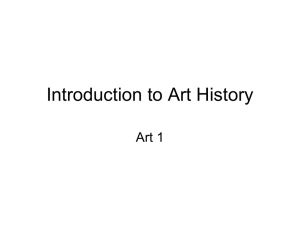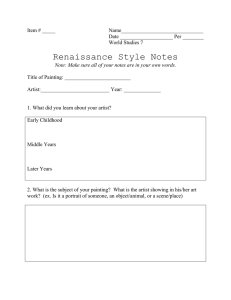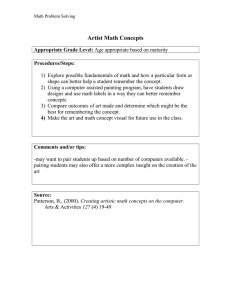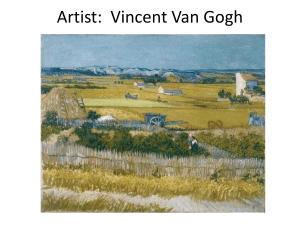CATEGORY 4: ALL STAR ARTISTS 1.
advertisement
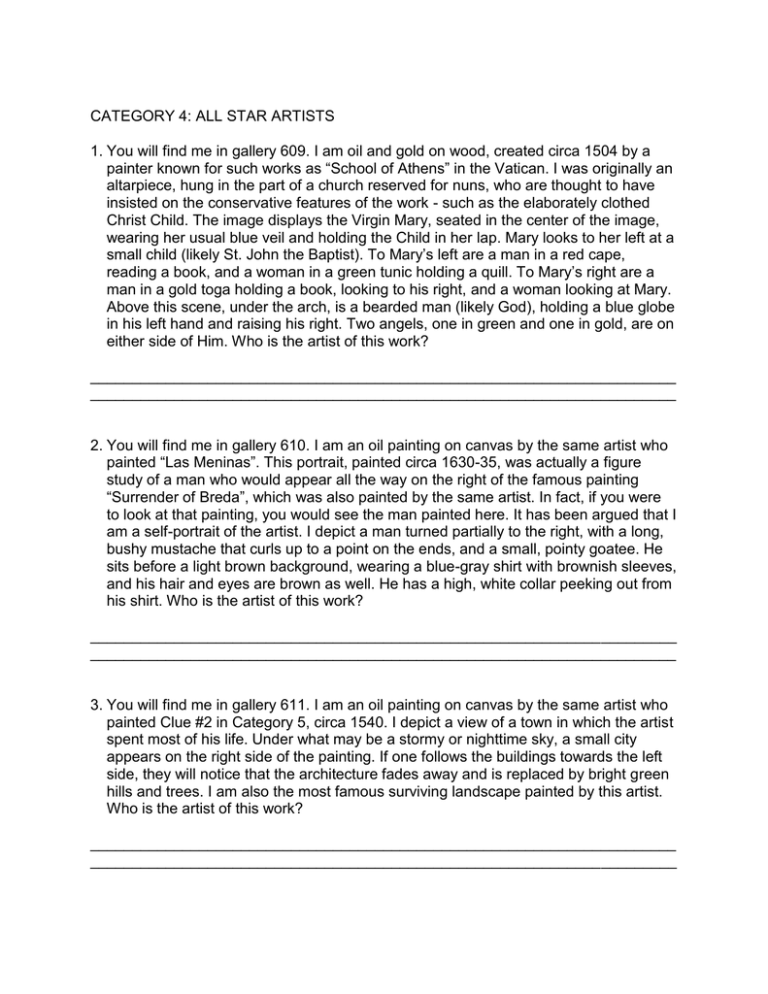
CATEGORY 4: ALL STAR ARTISTS 1. You will find me in gallery 609. I am oil and gold on wood, created circa 1504 by a painter known for such works as “School of Athens” in the Vatican. I was originally an altarpiece, hung in the part of a church reserved for nuns, who are thought to have insisted on the conservative features of the work - such as the elaborately clothed Christ Child. The image displays the Virgin Mary, seated in the center of the image, wearing her usual blue veil and holding the Child in her lap. Mary looks to her left at a small child (likely St. John the Baptist). To Mary’s left are a man in a red cape, reading a book, and a woman in a green tunic holding a quill. To Mary’s right are a man in a gold toga holding a book, looking to his right, and a woman looking at Mary. Above this scene, under the arch, is a bearded man (likely God), holding a blue globe in his left hand and raising his right. Two angels, one in green and one in gold, are on either side of Him. Who is the artist of this work? ______________________________________________________________________ ______________________________________________________________________ 2. You will find me in gallery 610. I am an oil painting on canvas by the same artist who painted “Las Meninas”. This portrait, painted circa 1630-35, was actually a figure study of a man who would appear all the way on the right of the famous painting “Surrender of Breda”, which was also painted by the same artist. In fact, if you were to look at that painting, you would see the man painted here. It has been argued that I am a self-portrait of the artist. I depict a man turned partially to the right, with a long, bushy mustache that curls up to a point on the ends, and a small, pointy goatee. He sits before a light brown background, wearing a blue-gray shirt with brownish sleeves, and his hair and eyes are brown as well. He has a high, white collar peeking out from his shirt. Who is the artist of this work? ______________________________________________________________________ ______________________________________________________________________ 3. You will find me in gallery 611. I am an oil painting on canvas by the same artist who painted Clue #2 in Category 5, circa 1540. I depict a view of a town in which the artist spent most of his life. Under what may be a stormy or nighttime sky, a small city appears on the right side of the painting. If one follows the buildings towards the left side, they will notice that the architecture fades away and is replaced by bright green hills and trees. I am also the most famous surviving landscape painted by this artist. Who is the artist of this work? ______________________________________________________________________ ______________________________________________________________________ 4. You will find me in gallery 612. I am an oil painting on canvas by the same artist who painted “Third of May, 1808”. I was painted in 1804, and depict a woman with long, flowing blondish hair, wearing a white dress. The woman is seated on a gold or umber bed, her hands over her stomach, indicating that she is with child (this is further alluded to by the informality of her hair and dress. The woman looks towards the viewer, behind her, and empty black background. Who is the artist of this work? ______________________________________________________________________ ______________________________________________________________________ 5. You will find me in gallery 615. I am an oil painting on canvas by the same artist who painted “The Swing”. I was painted in the early 1770s, and depict a young woman, looking over her shoulder towards the viewer, and holding a bouquet of flowers. She sits at a desk with papers on it, and a small note is tucked into the top right side of the bouquet. From a distance, the entire scene appears gold or brown, but up close some greens are visible in her gown, the desktop and the chair cushion. A small white dog with long ears sits behind her on the same chair. This is not a portrait, but a genre scene. Who is the artist of this work? ______________________________________________________________________ ______________________________________________________________________ 6. You will find me in gallery 628. I am an oil painting on wood by the same master painter who created Clue # 6 in Category 3. I was created circa 1635. I depict three figures. The adult male is the artist who created me. He wears a black hat and shirt, and gazes towards the female, his wife. His right hand is covered by a tannish glove, but his bare left hand rests under her right forearm. The woman, Helena, is the wife of the artist, and this painting pays tribute to her as a wife and mother. She is wearing a dark gown with a large white collar. In her right hand, she holds a rope that may be attached to the child. In her left hand she holds some sort of golden purse. She looks to the child, who looks back at her. The child is a male, wearing a tannish gown with a blue sash and apron. He looks to be about two years old. His head is covered with a white wrap, with a blue headband around it. He reaches towards his mother with his left hand. Both the husband and son look towards the woman lovingly. Who is the artist who painted this work? ______________________________________________________________________ ______________________________________________________________________ 7. You will find me in gallery 629. I am an oil painting on canvas that was created by the same artist who created the “Marriage a la Mode” series of paintings. I was painted in 1729, and I depict the wedding of a lawyer and his bride. Nine people in total are at the wedding. On the far left, a woman in a blue dress stands beside a man in an olive suit. The groom, followed by the bride (both in white and gray) stand next to him, followed by a man in brown, a minister, another man, and two women (the first in pink, the second in yellow). The room is painted mostly in goldish earth tones, and two putti fly overhead holding a horn of fruit. Who is the artist who painted this work? ______________________________________________________________________ ______________________________________________________________________ 8. You will find me in gallery 628. I am an oil painting on canvas, painted by the same master who painted “Charles I at the Hunt” in 1635. I was painted circa 1620-21. In this self-portrait, The image depicts me as a courtly gentleman, with no reference to my profession other than the painting itself. My father dealt with fine fabrics, which explains my rich attire. I stand leaning on a wall on my right elbow, my forearm raised, and my hand falling towards me (I have a ring on my pinky finger). My left arm is covered by a large, dark drape, but my left hand is visible, holding the wall that I’m leaning on. My shirt is a brownish red, and my white, ruffled sleeve and collar are visible. Who is the artist who painted this work? ______________________________________________________________________ ______________________________________________________________________ 9. You will find me in gallery 908. I am an oil painting on canvas, painted by the same artist from Clue # 1 in Category 6. I was painted in 1929. The image represents an individual stoically facing the onslaught of change in an industrial society to the artist, but many might not glean that just by looking at me. I appear to be a serene image of a lighthouse on a hill, with a fairly large house next to it. The sun hits the buildings from the right side of the canvas, casting all the shadows to the left of the buildings. Who is the artist who painted this work? ______________________________________________________________________ ______________________________________________________________________ 10. You will find me in gallery 624. I am a pastel drawing on blue laid paper, and I was created by the same artist who painted “An Experiment on a Bird in an Air Pump”. I was created circa 1770-72. I depict a woman, her head turned to the right, wearing an earring. Her hair is very high, and appears to be tied back somehow. She is wearing what is likely a square-collared dress of some kind, with a white ruffle trim. Who is the artist who drew this work? ______________________________________________________________________ ______________________________________________________________________ 11. You will find me in gallery 617. I am an oil painting on canvas by the same artist who painted Clue # 1 in Category 7. I was painted in the 1630s. I depict a youth having his fortune read by an old gypsy crone while her accomplices pickpocket him. The crone, on the right side of the composition, wears a red striped gown, and has her head wrapped in a white turban. She gestures towards his overturned left hand with her right one. Behind her is a woman in a white head wrap, head towards the viewer but eyes towards the man. The man has his head towards the viewer but his eyes towards the crone. His right hand (in a pink and tan striped sleeve), rests on his hip, and his left hand is flipped over to be read. He wears a tannish vest, with a pointy, white embroidered collar over it. His waist is tied with a red sash that matches his pants. Two women are behind and beside him. The one who pickpockets him has a white embroidered sleeve, and she pickpockets him with her right hand. Who is the artist who painted this work? ______________________________________________________________________ ______________________________________________________________________ 12. You will find me in gallery 621. I was painted by the same artist who painted “The Conversion of St. Paul” and “The Calling of St. Matthew”. This painting keeps with my “saints stories”. I was painted between 1571-1610, towards the end of the artist’s life. In the painting, a soldier on the left side with a helmet on, raises a red-sleeved arm to point at the man on the right, St. Peter. A woman between them in a white veil, with her face towards the guard, also points at St. Peter with her left hand. St. Peter, the bearded, bald man on the right of the composition, is wrapped in a gold toga, and draws his hands towards his chest defensively. Who is the artist that painted this work? ______________________________________________________________________ ______________________________________________________________________ 13. You will find me in gallery 774. I am an oil painting on canvas and I was painted by the same artist who painted “The Child’s Bath”. I was painted circa 1908-09. I depict a young woman named Denise with reddish brown hair in a white robe sitting in front of a mirror. The color of my hair matches the frame of the round mirror behind me. In my left hand I hold a gold mirror with a green backside, and I style my hair with my right hand, as I use the hand mirror to see the back of my head. Who is the artist that painted this work? ______________________________________________________________________ ______________________________________________________________________ 14. You will find me in gallery 764. I am an oil painting on canvas by the same artist who painted Clue # 6 in Category 6, and I was painted in 1867. I depict two men during a music rehearsal. The man with the beard in the foreground wears a dark jacket with tails and tan pants, playing the cello. Beside him, further from the viewer, is a man with a goatee, wearing a dark vest and pants with white sleeves playing the violin. They both face forward (to the right of the painting), reading music off their easels. A discarded folder of music is on the floor on the bottom right of the painting. Who is the artist that painted this work? ______________________________________________________________________ ______________________________________________________________________ 15. You will find me in gallery 771. I am an oil painting in canvas, and I was painted by the same artist who painted Clue # 5 in Category 6, in 1899. I depict the three Wyndham sisters posed together on a lavish white couch with a green cushion. Each sister wears a white gown, and has dark hair pulled into an up do. The sister on the far left has her left arm resting on the back of the couch, her right upturned in her lap. Both the collar of her dress and trip of her sleeve are trimmed in gold. She faces the right of the painting. The sister on the right side of the couch is the only one who looks at the viewer. Her right arm is raised, her fingers folded over into her hand. Her left arm rests along the arm of the couch, but her left hand is raised. Behind her is the third sister, who faces the left side of the painting, and has her back largely turned to the viewer. Though her arm is covered by a billowy large wrap, her hands can be seen behind her back on the arm of the couch. Many pictures, including one of a woman in a dark dress touching her neck with her left hand, hang in the background. White flowers, including white roses, can be found throughout the painting - including in the bottom right hand side. Who is the artist that painted this work? ______________________________________________________________________ ______________________________________________________________________ 16. You will find me in gallery 829. I am an oil painting on canvas by the same man who painted the famous goldleaf painting “The Kiss”, from 1912. I depict a girl name Mada, the daughter of the banker and industrialist Otto Primavesi and his wife, actress Eugenia. She is a pretty brunette who stands with her right hand on her hip and her left behind her back. Her hair is parted on the right side and on the left side of her head, she wears a large hair ornament. She wears a knee length white fit and flare dress with a ruffled bottom, with white tights and white shoes. Different color flowers make up the waistband of her dress, from purple to yellow to pink to red to purple to yellow to purple. The background is vastly purple, and the ground she stands on is green with red patterns in the top corners, and vastly white everywhere. The bottom has three blue zigzag stripes. Who is the artist that painted this work? ______________________________________________________________________ ______________________________________________________________________ 17. You will find me in gallery 902. I am an oil painting on canvas from 1927 by the same artist who painted Clue # 17 in Category 6 and Clue # 24 in Category 4. I can be considered a self-portrait, for the artist called himself “Harlequin”, and that is what is depicted here - but you will be hard-pressed to spot a harlequin easily in this image, for it is painted in the artist’s distinctive cubism distortion. On the top left margin, the artist has painted the shadow of his profile. When he painted the picture, the artist felt he was trapped in a failed marriage, the victim of his mentally unstable wife, Olga Kokhlova. He had already met the young woman who would become his lover, Marie-Therese Walter. The image is largely made up of earth tones. The border is off-white and taupe. The central rectangle is divided in half. On the left side, it is green with simple star shapes. The right side is brown, with a small periwinkle box on the bottom with an “x” through it. The figure in the center has white eyes, separated by a black “L” shape. Who is the artist that painted this work? ______________________________________________________________________ ______________________________________________________________________ 18. You will find me in gallery 907. I am made of oil and cut-and-pasted printed paper on cardboard in 1929 by the same artist who painted “The Persistence of Memory”. I am a Surrealist painting, but I am also a collage. There are several enlarged pebbles (each casting a shadow towards the top left of the brown ground they rest on), and on each of them there is another image. The pebble on the bottom right of the picture has a colony of ants along it’s center line, spreading out and symbolizing decay. The four pebbles to the left of that one feature the head of a lion. The one directly to the left of the ant pebble has removed the lion’s face. Above left of that one is a red silhouette of a lion’s head, and below left is the lion’s head in tact. A white silhouette of the lion’s head with only his mouth in tact is to the left of that. The picture symbolizes the artist’s anxiety over falling in love with a married, older woman. Who is the artist that painted this work? ______________________________________________________________________ ______________________________________________________________________ 19. You will find me in gallery 910. I am an oil painting on canvas from 1926 by the same artist who painted Clue # 7 in Category 6 and Clue # 20 in Category 4. I depict a black iris, but the image has been so enlarged that it is no longer immediately recognizable as a flower. The petals are mostly a purplish gray shade on top, and a dark gray, almost black shade on the bottom. Only the lip of the central petals (an eggplant color) and the area above it (a light pink) are outside of the gray family. This painting is a wonderful example of what made the artist famous - painting enlarged flowers and forcing the viewer to focus on details that might have been overlooked. Who is the artist who painted this work? ______________________________________________________________________ ______________________________________________________________________ 20. You will find me in gallery 910. I am an oil painting on canvas from 1937 by the same artist who painted Clue # 19 in Category 4 and Clue # 7 in Category 6. Rather like the painting in Category 6, I am a good example of the artist’s later subject matter - animal skulls and the American southwest. This particular painting depicts the skull of an indeterminate creature, with many antlers. The skull floats before a sky divided sharply between blue and pink, and over pinkish sand dunes with white peaks, resembling mountains. Who is the artist that painted this work? ______________________________________________________________________ ______________________________________________________________________ 21. You will find me in gallery 915. I am oil and graphite on canvas from 1986-87 by the same artist who created Fanny/Fingerpainting in 1985. I depict a man called Lucas, a friend of the artist. This artist is known for creating his portraits by drawing a grid on top of a photograph of a person and then enlarging the image when he paints it. Sometimes, the finished product also appears to have a grid in it, as in this particular painting. The painting itself of Lucas depicts the man from the neck up, and finds his forward-facing head in the center of the composition. He has a wild, unruly beard that matches his dark unruly hair, and appears to be wearing a plaid collared shirt. Who is the artist that painted this work? ______________________________________________________________________ ______________________________________________________________________ 22. You will find me in gallery 920. I am a sculpture made from painted aluminum, steel, steel rod and wire, created by the same artist who painted “Bird’s Nest” and sculpted “Spunk of the Month”. The title of this work also defines what the sculpture is. The work resembles the branch of a tree with a leaf at each end (17 in total). Who is the artist that sculpted this work? ______________________________________________________________________ ______________________________________________________________________ 23. You will find me in gallery 924. I am oil and magna on canvas from 1978 by the same artist who created “Drowning Girl” in 1963 and “Whaam!” in 1963. I depict a man and a woman. Only five colors appear in the painting - yellow, blue, red, black and white. The woman is on the left of the composition, her long yellow hair swoops to the left of her. Her blue eye is tilted vertically, just above her lips. She doesn’t have a nose. She wears a yellow cowl neck jacket with a black button at the collar. Her face is a rectangle. The man, more geometrically correct, wears a blue hat, and has a yellow rectangle over his eyes. He also has a striped blue tie and shirt, and wears a blue flower on his lapel. Who is the artist that painted this work? ______________________________________________________________________ ______________________________________________________________________ 24. You will find me in gallery 901. I am an oil painting on canvas from 1934 by the same artist who painted Clue # 17 in Category 4 and Clue # 17 in Category 6. In the picture, the artist’s twenty-five-year-old lover, Marie-Therese Walter, sits at a table reading, seemingly unaware of her crown of flowers. This chaste scene was set at the artist’s country home in Boisgeloup, in Normandy, where, in addition to painting, the artist produced large-scale sculptures and prepared many etchings. The picture depicts a woman sitting on the right side of the painting reading at a table with her right hand resting on her face. Her skin is purple with blue highlights, and her hair looks white. On her head is a green wreath with flowers on it. A tall, curly green plant is on the left side of the painting. She wears green and sits on a red chair. But the distortion that the artist is famous for appears in this scene, making it difficult to identify. Who is the artist that painted this work? ______________________________________________________________________ ______________________________________________________________________ 25. You will find me in gallery 920. I am an oil painting on canvas from 1943 by the same artist who painted Clue # 8 in Category 6. I depict a chaotic scene that may appear to just be large shapes on a canvas. This is the largest of the painter's mythologically themed pictures of the mid-1940s. Originally named Moby Dick, the picture was retitled before it was exhibited in 1944 when James Johnson Sweeney, a curator at the Museum of Modern Art, related the story of the Cretan princess Pasiphaë who gave birth to the half-man, half-bull Minotaur. Here the artist incorporates two sentinel-like standing figures at the left and right and a prostrate figure at center. The artist weaves these figures into a complex field of arcane symbols and free-form abstraction, his own novel interpretation of the Surrealist practice of automatism, wherein the artist's unconscious is used to organize composition. Who is the artist that painted this work? ______________________________________________________________________ ______________________________________________________________________ 26. You will find me in gallery 815. I am a sculpture made of bronze, partially tinted, with cotton skirt and satin hair ribbon on a wood base from 1880 (and cast in 1922) by the same artist who painted Clue # 9 in Category 6. I resemble most of the characters in that painting, as I am part of the series of work he completed on this particular subject. I am a young ballerina, posed with my hands behind my back, my face raised and my right foot stepping forward. Who is the artist that sculpted this work? ______________________________________________________________________ ______________________________________________________________________ 27. You will find me in gallery 819. I am an oil painting on canvas from 1882 painted by the same artist who painted Clue # 10 in Category 6. Like many paintings by this Impressionist artist, I feature flowers - they are pink and white, and they’re the focal point of the painting. The painting is classified as a still life, and the flowers are in a dark vase, sitting atop a brown, elegant end table, set against a bluish background. The name of the flowers is also the name of the painting. Who is the artist that painted this work? ______________________________________________________________________ ______________________________________________________________________ 28. You will find me in gallery 823. I am an oil painting on canvas from 1927 by the same artist who painted “Three Sisters and The Rose Marble Table” in 1917. I recall to mind another famous painting - “Grande Odalisque” by Ingres - in fact, the composition and subject matter is exactly that of the Ingres painting, but the woman is shown in a mirror image. Notwithstanding their kinship with earlier works by Ingres and Delacroix, the harem pictures Matisse made in Nice, such as this odalisque of 1927, had a more practical basis. As Matisse explained: "I paint odalisques in order to paint the nude. Otherwise, how is the nude to be painted without being artificial? But also, I know they exist. I was in Morocco. I saw them." The woman rests propped up on her left elbow on a pink and black striped pillow, and wears only gray pants that slump below her hips. She has short brown hair. Before her is a table set up with a plate of fruit, some of which has fallen off the plate. A black and white patterned vase is at the end of the table on the left side of the painting. The background is made up of a gold arched patterned area, a red area with a blue connected diamond pattern, and a red, yellow and black striped area on the left side of the painting. Who is the artist who painted this work? ______________________________________________________________________ ______________________________________________________________________ 29. You will find me in gallery 823. I am an oil painting on wood from 1896 by the same artist that painted “Where Do We Come From? Where Are We? Where Are We Going?” in 1897. The painting is a popular subject matter for the artist, as he spent much time in Tahiti. This painting of three Tahitian women, depicts them standing in front of a brook or a creek of some sort. The woman on the far left of the painting leans to her left, towards two other woman. She wears a white skirt. The other two women, standing very close, wear red wrapped dresses. The woman in the center holds her left hand in front of her face. She is in profile, wearing a wreath of flowers. The woman on the right has her body turned towards the center woman, her left arm at her side with her hand raised. She is also mostly in profile. Who is the artist who painted this work? ______________________________________________________________________ ______________________________________________________________________ 30. You will find me in gallery 823. I am an oil painting on canvas circa 1886-88 by the same artist who painted Clue # 13 in Category 6. I am a Pointillist painting depicting the same location from Clue # 13 in Category 6 - the island of Le Grande Jatte. This painting shows a small boat tied to a post on the shore. It is flanked by trees, and an area of buildings with red roofs are visible in the distance. Who is the artist who painted this work? ______________________________________________________________________ ______________________________________________________________________ 31. You will find me in gallery 823. I am oil mixed with sand on canvas from 1939 by the same artist who painted “Port en Normandie” in 1909. In this oil the artist presents a view of his studio, which he had built in 1931 at Varengeville, a small village on the Norman coast near Dieppe. Light from the central window streams into the room, illuminating the flower still life and the palette with brushes at the left and the wicker stool and easel holding a painting at the right. The colorful interior is a sea of merry patterns: floral wallpaper, wood grain, and the basket weave of the chair seat. The patterning continues to the exterior in the cloud-dappled sky. The background on the top right of the painting is orange, and on the top left is orange white tan and white flowers resembling wallpaper. Who is the artist that painted this work? ______________________________________________________________________ ______________________________________________________________________ 32. You will find me in gallery 955. I am an oil painting on canvas from 1911 by the same artist who painted “Bella with White Collar” in 1917. This painting depicts a view of the Eiffel Tower (which is painted pinkish). Power lines from the top right corner of the painting and a sharp band of blue from the top left both recede towards the tower, making it the focal point (as the orange brick wall on the bottom right corner does, and the red buildings above it). A horse is in the bottom left corner of the painting. Who is the artist that painted this work? ______________________________________________________________________ ______________________________________________________________________
